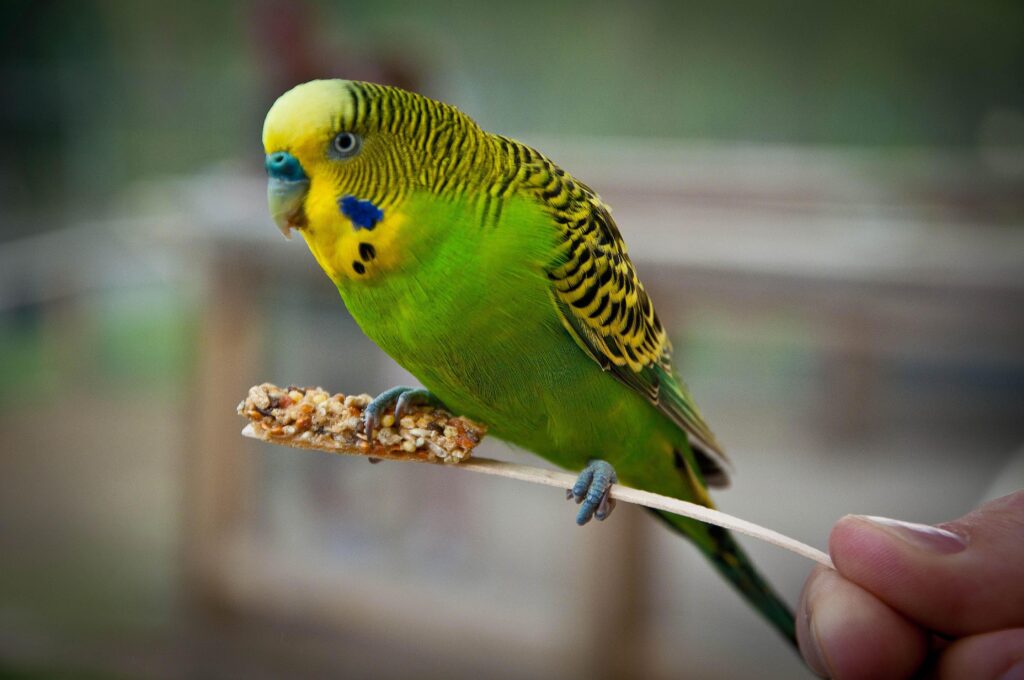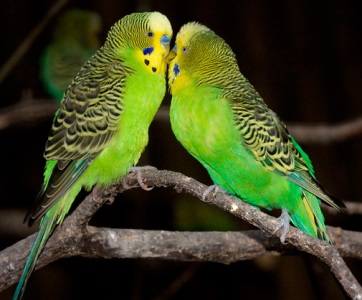
All About Budgies!

Budgies
Budgerigars (“budgies”) are small, colorful birds that are found in large numbers in the desert interiors of Australia. Because free ranging birds are accustomed to going days without water, it is not appropriate in captivity to use drinking water as a vehicle for administering vitamins or medications. The normal free-ranging budgie is green; other colors have resulted from selective breeding, which has actually produced undesirable characteristics, such as a significant increase in body mass and unusual feathering that interferes with normal body functions. Budgerigars are very easy to breed in captivity. Green birds are the most disease-resistant and probably have the longest life expectancy in captivity. Avoid purchasing a bird mill budgie sold in most chain pet stores. Contact a breeder with references to get a healthy bird.
Vital Statistics
Body length: 7 in
Body weight: 30 g
Age of sexual maturity: 4 mo
Average lifespan: 4 years
Maximum life span: 18 yr


What to Expect from Your Budgie
Budgerigars (commonly referred to as “parakeets” or “budgies”) are quiet, intelligent, nondestructive birds that are easy to care for. They are the most popular and numerous companion birds because of their relatively gentle, gregarious and entertaining personalities. They do not tend to bond with an individual person, and frequently interact with all family members. Budgerigars are capable of developing a large vocabulary (perhaps 200-300 words) but some effort must be made to accomplish this, and their voice is not as clear as other pet bird species. Some individuals are also good at whistling. Not talking at all is not unusual.
What Do Budgies Do All Day?
Budgies are playful and easily amused with simple toys. Because they (especially females) love to chew, toys must be free of toxic metals, hooks, sharp objects or small, easily consumed components. Providing small diameter, fresh-cut branches from nontoxic, pesticide-free trees is suggested for budgerigars. Check with your veterinarian for recommendations on locally available safe trees.


Is Your Budgie a Male or a Female?
Generally, in the normal green budgie, the cere (plump tissue above the beak) is blue in the male and pinkish brown in the female. This gender differentiation is not 100% accurate, nor does it apply to color mutations. Hormonal changes may affect the cere color
What Your Vet Looks For in a Healthy Budgie
Dry, Open Nares
Smooth Beak
Clear, Bright Eyes (No Discharge)
Alert, Erect Posture
Smooth, Bright Feathers Without Color Breaks, Transparency or Ragged
Edges
Body Free of Lumps and Bumps
Even, Reptilian Pattern on the Feet and Nails of Appropriate Length


Are Budgies Tame?
Young, hand-raised budgerigars adapt readily to new surroundings and handling procedures. They should be exposed early in life to novel situations (car travel, hospital visits, multiple visitors in the household, other household pets) so that they are well adjusted to these events. They are easily tamed; therefore, it is better to allow the parents to raise offspring in the nest and remove the young for taming at weaning. Young budgies can be identified by their large black eyes and stripes over the forehead.

How to Identify Your Bird
Two methods used to permanently mark companion birds for identification purposes are tattoos and microchips (both are injected under the skin). Individually number leg bands are not reliable for identification. Every bird has a unique scale pattern on the feet. Photographs of the feet (updated periodically as the bird ages) can be maintained in the bird’s record to confirm its identity and to prevent fraud that can occur with other techniques.
Housing for your Budgie should:
- be as large as possible.
- be clean, secure, safe and easy to service.
- be constructed of durable, nontoxic materials.
- contain variable-sized perches made of clean, nontoxic, pesticide-free tree branches.
- have food and water containers placed at opposite ends of the enclosure.
- avoid having perches located directly over food containers.
- offer occasional opportunity for protected outdoor exposure to fresh air, sunlight and exercise.


Budgies are very curious and will investigate anything new in their environment. That is why it is important to prevent their access to:
ceiling fans, hot cooking oil, Teflon-coated items (overheated), leg chains, sandpaper-covered perches, tobacco and cigarette smoke, chocolate, avocado, salt, alcohol, toxic houseplants, pesticides, toxic fumes, easily dismantled toys, dogs, cats, and young children, cedar, redwood and pressure-treated wood shavings, sources of lead or zinc.
Most Common Problems with Budgies
- Behavioral problems
- Feather and skin disorders
- Injuries
- Black splotches in feathers (malnutrition)
- Bleeding syndrome
- Bacterial infections
- Chlamydiosis
- Polyomavirus
- Papillomatosis
Many common disease conditions in conures are often the result of malnutrition. Visiting your avian veterinarian for routine health checks will help prevent many diseases and support you in having a long, satisfying relationship with your conure.


How to Keep Your Conure Healthy, Happy and Safe!
- Give lots of attention.
- Feed a fresh, high quality, toxin-free formulated diet,
such as Harrison’s Fine Grind formulas with daily supplementation of small
amounts of chopped vegetables and fruit according to the instructions on
the back of the bag. - Do not feed grit, as it is not necessary with modern
captive diets. - Provide clean, fresh uncontaminated water. Remove and replace food and water containers twice daily to maximize activity in a
healthy bird. - Provide an occasional opportunity for bath, shower or misting (at least weekly).
- Avoid spraying house with insecticides.
[save_as_pdf_pdfcrowd]

